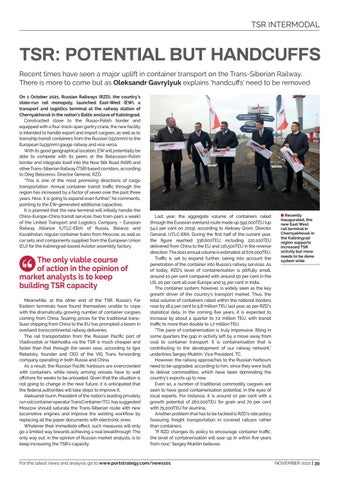TSR INTERMODAL
TSR: POTENTIAL BUT HANDCUFFS Recent times have seen a major uplift in container transport on the Trans-Siberian Railway. There is more to come but as Oleksandr Gavrylyuk explains ‘handcuffs’ need to be removed On 1 October 2021, Russian Railways (RZD), the country’s state-run rail monopoly, launched East-West (EW), a transport and logistics terminal at the railway station of Chernyakhovsk in the nation’s Baltic enclave of Kaliningrad. Constructed close to the Russo-Polish border and equipped with a four-track-span gantry crane, the new facility is intended to handle export and import cargoes, as well as to transship transit containers from the Russian (1520mm) to the European (1435mm) gauge railway and vice versa. With its good geographical location, EW will potentially be able to compete with its peers at the Belarusian-Polish border and integrate itself into the New Silk Road (NSR) and other Trans-Siberian Railway (TSR) based corridors, according to Oleg Belozerov, Director General, RZD. “This is one of the most promising directions of cargo transportation. Annual container transit traffic through the region has increased by a factor of seven over the past three years. Now, it is going to expand even further,” he comments, pointing to the EW-generated additional capacities. It is planned that the new terminal will initially handle the China-Europe-China transit services (two train-pairs a week) of the United Transport and Logistics Company – Eurasian Railway Alliance (UTLC-ERA) of Russia, Belarus and Kazakhstan, regular container trains from Moscow, as well as car sets and components supplied from the European Union (EU) for the Kaliningrad-based Avtotor assembly factory.
‘‘
The only viable course of action in the opinion of market analysts is to keep building TSR capacity Meanwhile, at the other end of the TSR, Russia’s Far Eastern terminals have found themselves unable to cope with the dramatically growing number of container cargoes coming from China. Soaring prices for the traditional transSuez shipping from China to the EU has prompted a boom in overland transcontinental railway deliveries. The rail transportation from the Russian Pacific port of Vladivostok or Nakhodka via the TSR is much cheaper and faster than that through the seven seas, according to Igor Rebelsky, founder and CEO of the VIG Trans forwarding company operating in both Russia and China. As a result, the Russian Pacific harbours are overcrowded with containers, while newly arriving vessels have to wait offshore for weeks to be unloaded. Given that the situation is not going to change in the near future, it is anticipated that the federal authorities will take steps to improve it. Aleksandr Isurin, President of the nation’s leading privately run rail container operator TransContainer (TC), has suggested Moscow should saturate the Trans-Siberian route with new locomotive engines and improve the existing workflow by replacing all the paper documents with electronic ones. Whatever their immediate effect, such measures will only go a limited way towards achieving a real breakthrough. The only way out, in the opinion of Russian market analysts, is to keep increasing the TSR’s capacity.
Last year, the aggregate volume of containers railed through the Eurasian overland route made up 592,000TEU (up 54.2 per cent on 2019), according to Aleksey Grom, Director General, UTLC-ERA. During the first half of the current year, the figure reached 336,600TEU, including 220,100TEU delivered from China to the EU and 116,500TEU in the reverse direction. The 2021 annual volume is estimated at 670,000TEU. Traffic is set to expand further, taking into account the penetration of the container into Russia’s railway services. As of today, RZD’s level of containerisation is pitifully small, around 10 per cent compared with around 50 per cent in the US, 20 per cent all over Europe and 15 per cent in India. The container system, however, is widely seen as the key growth driver of the country’s transport market. Thus, the total volume of containers railed within the national borders rose by 16.5 per cent to 5.8 million TEU last year, as per RZD’s statistical data. In the coming five years, it is expected to increase by about a quarter to 7.2 million TEU, with transit traffic to more than double to 1.7 million TEU. “The pace of containerisation is truly impressive, filling in some quarters the gap in activity left by a move away from coal to container transport. It is containerisation that is contributing to the development of our railway network,” underlines Sergey Mukhin, Vice President, TC. However, the railway approaches to the Russian harbours need to be upgraded, according to him, since they were built to deliver commodities, which have been dominating the country’s exports up to now. Even so, a number of traditional commodity cargoes are seen to have good containerisation potential, in the eyes of local experts. For instance, it is around 10 per cent with a growth potential of 260,000TEU for grain and 70 per cent with 75,000TEU for alumina. Another problem that has to be tackled is RZD’s rate policy favouring freight transportation in covered railcars rather than containers. “If RZD changes its policy to encourage container traffic, the level of containerisation will soar up in within five years from now,” Sergey Mukhin believes.
For the latest news and analysis go to www.portstrategy.com/news101
8 Recently inaugurated, the new East West rail terminal in Chernyakhovsk in the Kaliningrad region supports increased TSR activity but more needs to be done system wide
NOVEMBER 2021 | 39
















